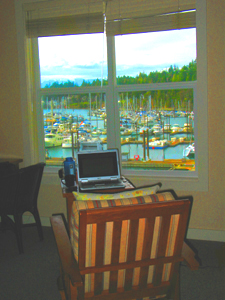 Come to find out that writing creepy is hard! I’d arrived at Ghost Story Weekend without an idea, thinking no biggie, something will come, it always does. On Friday night when most of the other 12 writers at the retreat tapped away, tap-tap-tap, on their short stories, and with only 24 hours to write a first draft, I found myself doing the Jack Nicholson:
Come to find out that writing creepy is hard! I’d arrived at Ghost Story Weekend without an idea, thinking no biggie, something will come, it always does. On Friday night when most of the other 12 writers at the retreat tapped away, tap-tap-tap, on their short stories, and with only 24 hours to write a first draft, I found myself doing the Jack Nicholson:
“…I don’t know what to write I don’t know what to write. Image of a girl walking her dog…so stupid with no other character on the scene. But maybe the people in the houses — the people she sees through the windows are the creep-factors. Stepford-wife-like neighborhoods are creepy. So what would this girl be — blah! I don’t have an idea I don’t know what to write I don’t know what to write…”
About half of us sat in the haunted boathouse while the others wrote in the bungalows. When we’d met with our hostess, novelist Elizabeth Engstrom, earlier in the evening, I’d noticed that most of my fellow crazy people looked confident. Even the few who’d arrived without a story idea looked confident that they’d find and finish their stories. For some reason, I was stuck on the word “creepy.”
I wasn’t in a creepy mood. I was having too much fun reunionizing and meeting people, enjoying the unusually warm weather, relishing the time away from my moronic downstairs neighbors, and drinking red wine. If anything, I was in a sarcastic mood. I kept hearing a flippant little first-person voice poking fun at everything ghostly.
 But…I was also torturing myself in classic writerly fashion: I must give creepy a try.
But…I was also torturing myself in classic writerly fashion: I must give creepy a try.
Saturday dawned cloudy with wind enough to stir Siltcoos Lake and set the boathouse to swaying. I had nothing. No revelations in the night despite the index cards and pen sitting next to my pillow. EFF-this, I thought, I’m going with my sarcastic voice. As long as my story contains some species of ghostly phenomena, I’m golden.
Then, what do you know, I had a blast writing my story. Now my desperation was all about finishing the draft by 6:00 p.m. that evening. I started with a voice and a setting — plus something to poke fun at: ghost hunters. Didn’t know where it was going, how to end it, or what the point of the whole thing was. After awhile, I didn’t care, and, in the end, I even managed a little creepiness.
Lessons learned or relearned?
1. Jump in, the story will follow. Sometimes it’s best not to think too hard about it.
2. Go with the voice in my head that’s yelling the loudest.
3. Creepiness comes when you least expect it.





